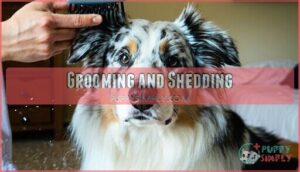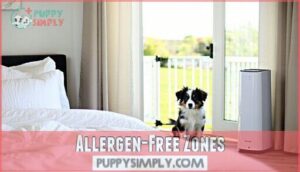This site is supported by our readers. We may earn a commission, at no cost to you, if you purchase through links.

These dogs have thick double coats that shed year-round, releasing dander and allergens throughout your home.
The proteins in their saliva and skin cells trigger allergic reactions in sensitive people.
While no dog is completely hypoallergenic, Aussies rank among the worst breeds for allergy sufferers because their dense fur traps and spreads allergens efficiently.
If you’re allergic to dogs but love Australian Shepherds, you’ll need specific strategies to manage your symptoms and reduce exposure to allergens in your living space.
Table Of Contents
- Key Takeaways
- Australian Shepherd Allergies
- Are Australian Shepherds Hypoallergenic
- Dog Allergies Explained
- Australian Shepherd Shedding
- Managing Allergies With Australian Shepherds
- Hypoallergenic Alternatives
- Minimizing Allergies With Australian Shepherds
- Australian Shepherd Allergy Considerations
- Living With Australian Shepherds and Allergies
- Frequently Asked Questions (FAQs)
- Are Australian Shepherds good for people with allergies?
- What is the most hypoallergenic dog ever?
- What are the disadvantages of an Australian Shepherd?
- Do Australian Shepherds shed heavily?
- Can Australian Shepherds trigger asthma attacks?
- Do spayed females produce fewer allergens?
- Are Australian Shepherd puppies less allergenic?
- How long do allergens stay airborne?
- Can allergy shots help with Aussies?
- Conclusion
Key Takeaways
- Australian Shepherds aren’t hypoallergenic – They produce the same allergens (Can f 1 and Can f 2 proteins) found in all dog breeds through their dander, saliva, and urine, making them unsuitable for most allergy sufferers.
- Their double coat creates heavy shedding – You’ll deal with moderate to heavy year-round shedding that spreads allergens throughout your home, with intense seasonal "blowouts" twice yearly that worsen exposure.
- You can manage symptoms but not eliminate them – Regular grooming, HEPA filters, and allergen-free zones help reduce exposure, but you’ll still face ongoing allergic reactions since no management strategy removes all allergens.
- Consider truly hypoallergenic alternatives – Breeds like Poodles, Portuguese Water Dogs, and Bichon Frises produce fewer allergens and shed less, making them better choices if you have significant dog allergies.
Australian Shepherd Allergies
If you’re considering an Australian Shepherd but have allergies, you need to understand what triggers your reactions.
These dogs produce allergens through their skin cells, saliva, and urine that can cause sneezing, itchy eyes, and breathing problems in sensitive people.
Causes of Allergies
Understanding dog allergies starts with knowing what triggers them.
Your Australian Shepherd produces three main allergens: dander proteins from skin cells, saliva allergens from drool and licking, and urine proteins.
When these allergens enter your body, your immune system mistakes them for threats, triggering histamine release.
This immune response causes those uncomfortable allergy symptoms you experience around dogs, which can be attributed to the immune system mistaking harmless substances for threats.
Symptoms of Allergies
When you’re exposed to Australian Shepherd allergens, your body launches an immune response that can make you feel miserable.
Your dog’s allergens turn your immune system into an overprotective bodyguard, attacking harmless proteins like they’re dangerous invaders.
Dog allergy symptoms range from mild discomfort to severe reactions that disrupt your daily life.
- Respiratory Issues – You’ll experience sneezing, coughing, wheezing, and difficulty breathing as your airways react to allergens
- Nasal Congestion – Your nose becomes stuffy, runny, or completely blocked, making breathing through your nose nearly impossible
- Eye Irritation – Your eyes become red, watery, and itchy, often accompanied by swelling around the eyelids
- Itchy Throat – You’ll feel a persistent scratching sensation in your throat that worsens with continued exposure
- Skin Reactions – Itchy skin, hives, and eczema flare-ups appear where allergens contact your body directly
These reactions can be exacerbated by common Australian Shepherd health issues.
Allergen Production
Australian shepherds produce allergens through their skin, saliva, and urine.
The Can f 1 protein in dander affects 70% of allergic people.
Males create more allergens than females due to hormonal differences.
Notably, reactions to dogs are often triggered by dog saliva proteins.
| Allergen Source | Primary Protein | Impact Level |
|---|---|---|
| Dander Composition | Can f 1, Can f 2 | High – most common trigger |
| Saliva Proteins | Can f 1, Can f 6 | Medium – spread through licking |
| Urine Allergens | Can f 5 (males only) | Low – affects fewer people |
| Breed Variation | All Can f proteins | Variable – individual differences |
Your dog’s protein production varies by genetics and health.
Oily skin doubles allergen levels compared to normal skin.
Australian shepherd shedding spreads these proteins throughout your home, making hypoallergenic dogs a myth for this breed.
Are Australian Shepherds Hypoallergenic
The answer is no – Australian Shepherds aren’t hypoallergenic and can trigger allergic reactions in sensitive individuals.
Despite some misconceptions, no dog breed is scientifically proven to be truly hypoallergenic, and Australian Shepherds produce the same allergens as other dogs.
Definition of Hypoallergenic
The term "hypoallergenic" means something is less likely to cause allergic reactions, but it doesn’t guarantee complete safety.
You’ll find no scientific backing for this claim regarding dogs, creating misleading terminology that sets unrealistic consumer expectations.
Here’s what you need to know about hypoallergenic claims:
- No Allergen-Free Guarantee – All dogs produce allergens regardless of breed
- Limited Allergenicity – Some breeds may produce fewer allergens, not zero
- Unregulated Term – The FDA doesn’t regulate "hypoallergenic" for pet marketing
- Individual Variation – Each dog’s allergen production differs, making breed generalizations unreliable
Myth of Hypoallergenic Dogs
Marketing tactics deceive you into believing hypoallergenic dogs exist, but there’s no allergen-free guarantee.
The FDA doesn’t regulate this term for pets, allowing companies to make false claims without scientific backing.
Dog allergies affect everyone differently, yet no breed truly prevents allergic reactions.
These marketing strategies create false expectations, leading families to adopt dogs that still trigger australian shepherd allergies and other dog breeds for allergies issues.
Scientific Evidence
Research consistently shows that no dog breed is truly hypoallergenic, including Australian shepherds.
Multiple allergen studies reveal homes with so-called hypoallergenic dogs contain similar allergen levels as other breeds.
Here’s what dander analysis and protein research demonstrate:
- Australian shepherds produce identical allergenic proteins (Can f 1-6) as all breeds
- Breed comparisons show more variation between individual dogs than breeds
- Allergen levels remain consistent regardless of coat type or shedding patterns
- Dog allergies stem from proteins in saliva, dander, and urine—not hair itself
- Allergy research confirms no scientific basis for hypoallergenic dog claims.
Due to their thick double coat, Australian Shepherds are prone to constant shedding.
Dog Allergies Explained
Dog allergies happen when your immune system overreacts to proteins found in a dog’s dander, saliva, and urine.
Your body releases histamine to fight these harmless proteins, causing symptoms like sneezing, runny nose, itchy eyes, and sometimes breathing problems.
Proteins in Dander and Saliva
Dog proteins that trigger allergic reactions come from two main sources: dander and saliva.
Can f 1 and Can f 2 are the primary allergens found in both, with Can f 1 affecting 43-75% of dog-allergic people.
Saliva contains more diverse protein types than dander, including Can f 5 from intact males.
Protein variation between individual dogs matters more than breed differences when predicting reactions.
Environmental changes, like using effective air purifiers, can further reduce allergens.
Immune System Reaction
When you’re exposed to dog allergens, your immune system mistakenly identifies harmless proteins as dangerous invaders.
This protein overreaction triggers histamine release, causing your body to launch an immune response against these perceived threats.
Your allergy threshold determines how much exposure you can handle before symptom severity increases, making some people react more intensely than others to the same allergens.
Allergy Symptoms
When your immune system overreacts to dog proteins, you’ll experience uncomfortable allergy symptoms.
Nasal congestion, runny nose, and itchy throat are common respiratory issues.
You might also develop skin reactions like hives or eczema.
Eye irritation with watery, red eyes frequently occurs.
These allergic reactions to Australian shepherd allergies can range from mild to severe, affecting your daily comfort and breathing.
Australian Shepherd Shedding
Australian Shepherds have a double coat that sheds moderately to heavily year-round, with heavier shedding during seasonal changes.
This shedding pattern spreads dander and saliva proteins throughout your home, making them unsuitable for people with dog allergies.
Double Coat and Shedding
Australian shepherds pack a double-coat punch that creates shedding challenges year-round.
Their dense undercoat releases the most allergens, especially during seasonal shedding periods when they "blow coat." You’ll notice heavier shedding in spring and fall as temperatures change.
Here’s what drives their shedding severity:
- Undercoat Allergens – The soft inner layer traps dander and releases it when shed
- Seasonal Shedding – Twice yearly coat changes increase allergen exposure substantially
- Grooming Frequency – Daily brushing helps control loose fur and dander buildup
Impact on Allergenicity
The double coat creates a perfect storm for allergen distribution throughout your home.
Coat type substantially influences dander production, with Australian shepherds’ thick undercoat trapping saliva proteins and dead skin cells.
Individual sensitivity varies greatly among people, making some more reactive to these allergens than others.
| Allergen Factor | Impact on Sensitivity |
|---|---|
| Dander production | High due to double coat shedding |
| Saliva proteins | Spread through grooming and licking |
| Allergen variation | Differs between individual dogs |
Grooming and Shedding
Regular brushing frequency matters more than you think for managing australian shepherd shedding.
Daily grooming with proper grooming tools like undercoat brushes removes loose fur before it spreads allergens throughout your home.
Understanding shedding patterns helps you time coat maintenance better.
Choosing the right brush is essential for effective grooming.
Combine consistent dog grooming with weekly bathing techniques to minimize dander buildup and control allergen levels effectively.
Managing Allergies With Australian Shepherds
If you’re dealing with allergies but love Australian Shepherds, you can take steps to reduce your exposure to allergens.
Management strategies include lifestyle changes, medical treatments, and prevention techniques that help minimize allergic reactions while living with your Aussie.
This approach allows you to enjoy your life with your pet, implementing strategies to reduce the impact of allergies.
Lifestyle Adjustments
When living with an Australian Shepherd, you’ll need to make smart lifestyle adjustments for effective allergy management.
Creating allergy-free zones and practicing good hygiene practices helps reduce your exposure to allergens throughout your home.
Here are essential allergy solutions you can implement:
- Establish allergy-free zones in bedrooms and main living areas where your Aussie isn’t allowed
- Engage in low-contact activities like outdoor fetch games that minimize direct contact with dander
- Install air purifiers with HEPA filters to capture airborne allergens and provide allergy relief
Regular cleaning becomes your best friend for allergy prevention, keeping dander levels manageable in your living space.
Medical Advice and Treatment
When allergies persist despite your best efforts, it’s time to consult your doctor about allergy medications and treatment options.
Antihistamines, nasal sprays, and eye drops provide symptom relief for daily management.
For severe reactions, immunotherapy options like allergy shots can offer long-term benefits.
Emergency treatment plans guarantee you’re prepared for unexpected flare-ups, while specialist consultations help create personalized medication protocols.
Allergy Prevention
Prevention starts with controlling your environment before allergens become a problem.
You can reduce dander through regular grooming, establish allergen barriers with HEPA air purification systems, and create allergy-friendly environments using proper hygiene practices.
Diet impact on your dog’s skin health also affects allergen production, making these dog allergy prevention tips essential for managing symptoms effectively, which is crucial for managing symptoms.
Hypoallergenic Alternatives
If you’re seeking dog breeds that produce fewer allergens than Australian Shepherds, several low-shedding options exist that may better suit allergy sufferers.
Poodles, Portuguese Water Dogs, and Soft-Coated Wheaten Terriers are commonly recommended alternatives due to their coat characteristics and reduced dander production.
Breeds With Low Shedding
Several low-shedding breeds offer better options for people with dog allergies than Australian Shepherds.
Bichon Frise dogs receive a 1/5 shedding rating, while Maltese and Yorkshire Terriers rank among the lowest shedding breeds.
These hypoallergenic dogs produce less dander and require different grooming frequency compared to double-coated breeds, helping reduce allergy thresholds for sensitive individuals with dog allergies.
Poodle and Portuguese Water Dog
When you’re looking for truly hypoallergenic dogs, Poodles and Portuguese Water Dogs stand out as top choices.
These breeds produce fewer allergens compared to Australian Shepherds, making them better options for allergy sufferers.
- Poodle Allergens: Their curly coats trap dander instead of releasing it into the air
- Water Dog Dander: Portuguese Water Dogs have single coats that shed minimally
- Breed Comparison: Both require regular grooming but offer superior allergy management over double-coated breeds
Soft-Coated Wheaten Terrier
Soft-Coated Wheaten Terriers offer another option for allergy sufferers seeking hypoallergenic dogs.
Their single-layered silky coat sheds minimally, though regular Wheaten Grooming prevents matting.
These allergy-friendly dogs combine gentle Wheaten Temperament with moderate Wheaten Exercise needs.
While no dog breeds for allergies are completely allergen-free, Wheatens produce fewer allergens than shepherds.
Some owners find that regular vacuuming helps to further reduce allergens.
Consider Wheaten Health screening and their Irish Wheaten History when choosing this breed for managing dog allergies.
Minimizing Allergies With Australian Shepherds
While you can’t eliminate allergens completely from your Australian Shepherd, you can substantially reduce their impact through consistent management strategies.
Regular grooming, proper air filtration, and creating allergen-free spaces in your home will help minimize exposure and make living with your Aussie more comfortable.
Regular Grooming and Bathing
Daily brushing and regular bathing substantially reduce allergen levels in your Australian shepherd’s coat.
Proper grooming techniques remove loose dander and saliva proteins that trigger allergic reactions. A good option is to think about an undercoat grooming tool.
- Brushing Frequency: Daily brushing with an undercoat rake removes 80% of loose fur and dander
- Bathing Techniques: Weekly baths with hypoallergenic shampoo wash away accumulated allergens
- Product Selection: Use dander-reducing sprays and allergen-neutralizing conditioners between baths
- Professional Grooming: Monthly professional sessions guarantee thorough shedding control and coat health
HEPA Filters and Vacuuming
HEPA filters trap 99.97% of particles, making your vacuum cleaner a powerful ally against dog allergies.
Regular filter maintenance guarantees maximum HEPA effectiveness for dander removal.
Clean filters weekly and replace them every six months for maximum allergen reduction.
Vacuum carpets, furniture, and pet bedding twice weekly using slow, overlapping strokes.
For maximum cleaning, consider a vacuum with HEPA.
This cleaning frequency creates allergy-friendly environments by substantially reducing airborne particles, making your space cleaner with HEPA filters.
Allergen-Free Zones
Create designated spaces in your home where your Australian shepherd can’t access to establish effective allergen control.
Bedrooms work best as allergy-free zones since you spend hours sleeping there.
Install air purifiers in these restricted access areas and clean surfaces frequently to remove dander.
One helpful approach involves using air purifiers for pets to minimize allergens.
This zone creation strategy provides relief when australian shepherd allergies become overwhelming.
Australian Shepherd Allergy Considerations
Before bringing an Australian Shepherd into your home, you’ll need to consult with an allergist to assess your specific sensitivities and determine if this breed is right for you.
Trial visits with Australian Shepherds can help you gauge your individual allergic reactions and make an informed decision about pet ownership.
Consultation With Allergist
Before making any decisions about living with an Australian Shepherd, you should consult an allergist for professional allergy testing and personalized advice.
An allergist can determine your specific thresholds through allergy diagnosis and recommend appropriate allergy treatment options, including immunotherapy options for long-term symptom management.
- Allergy testing confirms whether you’re actually allergic to dog proteins or other environmental triggers
- Doctor consultation provides personalized treatment plans based on your specific allergy severity and triggers
- Symptom management strategies help you understand realistic expectations before bringing home an Australian Shepherd
Trial Visits and Assessments
Before committing to an Australian shepherd, you should spend time with the breed to assess your personal reaction.
Schedule visits with different dogs to monitor symptom monitoring and reaction severity during varying exposure duration.
This hands-on approach provides valuable data for post-visit analysis.
Environmental control during these meetings helps determine if you can manage dog allergies through allergy testing rather than relying on assumptions about hypoallergenic dogs.
Individual Allergic Reactions
Your body’s reaction to an Australian Shepherd isn’t predictable based on breed alone.
Each person has unique symptom thresholds and individual tolerance levels for specific proteins found in dog allergens.
Standard allergy tests check for general dog allergies but can’t predict your exact response to a particular Australian Shepherd.
Exposure minimization strategies work differently for everyone, making personal assessment essential before committing to ownership.
Living With Australian Shepherds and Allergies
You’ll face ongoing challenges when living with an Australian Shepherd if you have allergies, but proper management can make coexistence possible.
Success requires consistent grooming routines, medical support, and realistic expectations about long-term allergen exposure.
Balancing Pet Ownership and Allergies
Living with allergies while owning an Australian shepherd requires careful planning and realistic expectations.
You’ll need to weigh your love for these dogs against potential health impacts and ongoing management costs.
Key considerations for balancing allergies and Australian shepherd ownership:
- Allergy thresholds – Determine your tolerance level through medical testing before committing to ownership
- Financial implications – Budget for regular grooming, air purifiers, medications, and potential veterinary bills
- Emotional wellbeing – Consider how constant allergy symptoms might affect your quality of life
- Family dynamics – Make certain all household members can manage exposure to this non-hypoallergenic breed
- Support networks – Connect with other owners managing dog allergies for practical advice and encouragement
Remember, Australian shepherds aren’t hypoallergenic dogs, so you’re not choosing from allergy-friendly dogs when selecting this breed.
Long-Term Management and Care
Long-term dog allergy management requires consistent grooming schedules to minimize dander buildup on your australian shepherd’s coat.
Environmental control through HEPA filters and regular cleaning becomes routine maintenance rather than crisis intervention.
Veterinary checkups help monitor both your dog’s skin health and your allergy symptoms, and diet considerations may improve coat quality, potentially reducing allergen production.
Allergy immunotherapy offers hope for severe cases, though results vary, and successful hypoallergenic living depends on maintaining these practices consistently over years.
Health and Wellbeing of Owners and Pets
Your well-being matters as much as your australian shepherd’s happiness when managing dog allergies together.
Owner mental health improves when you create realistic expectations about hypoallergenic myths while maintaining your pet’s exercise needs and balanced pet diet.
A safe home environment reduces owner stress through proper allergen management, letting you enjoy your non-allergyfriendly dog without compromising health, which is crucial for your overall well-being.
Frequently Asked Questions (FAQs)
Are Australian Shepherds good for people with allergies?
Don’t let sleeping dogs lie about allergies.
Australian Shepherds aren’t hypoallergenic and can trigger allergic reactions in sensitive people.
They shed moderately to heavily, spreading dander and allergens throughout your home, making them unsuitable for most allergy sufferers, as they can trigger allergic reactions.
What is the most hypoallergenic dog ever?
No dog breed is scientifically proven to be completely hypoallergenic. Breeds like Poodles, Xoloitzcuintlis, and Bichon Frises produce fewer allergens, but you’ll still encounter some proteins that trigger reactions.
What are the disadvantages of an Australian Shepherd?
Like shepherding your expectations can go astray, Australian Shepherds bring challenges you’ll need to navigate.
They’re high-energy dogs requiring extensive daily exercise, mental stimulation, and consistent training.
Their heavy shedding creates significant grooming needs and household cleanup demands.
Do Australian Shepherds shed heavily?
Yes, Australian Shepherds shed heavily due to their double coat. You’ll notice moderate shedding year-round with intense seasonal "blowouts" twice yearly when they shed their undercoat completely.
Can Australian Shepherds trigger asthma attacks?
Australian Shepherds can trigger asthma attacks in sensitive individuals. Their dander, saliva, and urine contain allergens that worsen respiratory symptoms, causing breathing difficulties and chest tightness when you’re exposed.
Do spayed females produce fewer allergens?
Sarah’s intact male Australian Shepherd triggered her allergies more than her friend’s spayed female, but both dogs still caused reactions.
Spaying doesn’t substantially reduce allergen production in female dogs.
The primary allergens come from skin dander and saliva proteins that remain present regardless of spay status.
Are Australian Shepherd puppies less allergenic?
No, Australian Shepherd puppies aren’t less allergenic than adult dogs.
They produce the same allergens (Can f 1 proteins) in their saliva, urine, and dander that trigger allergic reactions in sensitive individuals.
How long do allergens stay airborne?
Picture tiny invisible particles floating through your home like dust motes in sunbeams.
Dog allergens remain airborne for 20-30 minutes after disturbance, then settle on surfaces where they can linger for months, ready to become airborne again, which is a significant factor in the persistence of airborne allergens.
Can allergy shots help with Aussies?
Allergy shots can help reduce your sensitivity to Australian Shepherd allergens over time. This immunotherapy treatment gradually builds tolerance, making symptoms more manageable when you’re around your Aussie.
Conclusion
Sarah spent thousands on allergy medications before finally accepting that her Australian Shepherd was the culprit.
Are Australian Shepherds hypoallergenic? Absolutely not.
These dogs produce significant allergens through their double coats, dander, and saliva proteins.
While you can manage symptoms through regular grooming, air filtration, and cleaning routines, Aussies remain problematic for allergy sufferers.
Consider truly hypoallergenic breeds like Poodles or Portuguese Water Dogs if allergies severely impact your daily life.
- https://articles.hepper.com/are-australian-shepherds-hypoallergenic/
- https://rockykanaka.com/fur-or-foe-the-real-deal-on-australian-shepherds-and-allergies/
- https://timberwolfpet.com/blogs/dog-facts/are-australian-shepherds-hypoallergenic
- https://pmc.ncbi.nlm.nih.gov/articles/PMC5809771/
- https://hiccpet.com/blogs/dogs/why-do-australian-shepherds-shed

















